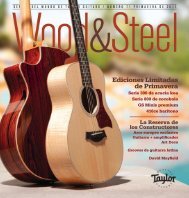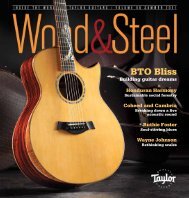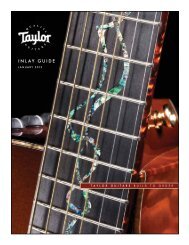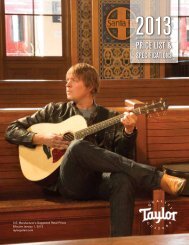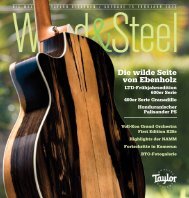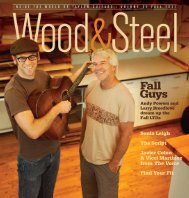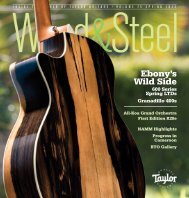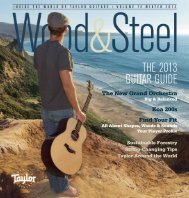Create successful ePaper yourself
Turn your PDF publications into a flip-book with our unique Google optimized e-Paper software.
27<br />
In contrast, on the guitar we have<br />
several different and equally confusing<br />
ways to play the C major scale (Ex. 5,<br />
6 and 7), and these examples are only<br />
three of virtually endless possibilities.<br />
Now let me reassure you why the guitar<br />
is still a good instrument choice. Once<br />
you’ve learned the pattern shown in<br />
Example 7, you’ll actually know all 12<br />
major scales! All you need to do is start<br />
the pattern on a different fret. If you<br />
want to play the G scale, then start<br />
the pattern shown in Example 7 at the<br />
third fret. E-flat major? Same pattern<br />
at the 11th fret. Got it? Antithetically,<br />
piano players have to learn 12<br />
different patterns for all 12 major keys.<br />
I point this out to illustrate that all<br />
instruments have their advantages and<br />
disadvantages.<br />
Now let’s move onto some essential<br />
building blocks of music theory: scales.<br />
Ex. 1<br />
Ex. 8: C Major scale<br />
The Irrational Fretboard<br />
Ex. 5: C Major scale with open strings Ex. 6: C Major scale with one string<br />
Ex. 9: G Major scale<br />
Ex. 7: C Major scale in a closed position<br />
Which Scale Do I Use?<br />
Knowing that the guitar’s layout is<br />
lacking in divine logic, let’s tackle a<br />
salient question: “Why are the scales<br />
laid out in so many different ways on<br />
the guitar?” Before I tell you why, let<br />
me explain how scales are made.<br />
All scales — major, minor,<br />
pentatonic, etc. — are simply a series<br />
of ordered steps, starting on any given<br />
pitch and ending on the same pitch<br />
an octave higher or lower. For our<br />
purposes we’ll stick with the major<br />
scale because all Western music<br />
theory is based on this scale. Example<br />
8 shows the C major scale and the<br />
series of steps that it contains (W =<br />
whole step; H = half step): W – W –<br />
H – W – W – W – H. (Note: Many<br />
theory books also use the terms Tone<br />
[T] for a whole step and Semitone [S<br />
or s] for half steps.) This is how all<br />
12 major scales are made. Example<br />
9 shows the G major scale. As you<br />
can see, it contains the same order of<br />
whole steps and half steps but starts<br />
and ends on the pitch G. It’s that<br />
easy! Now that we understand the<br />
construction of this essential element,<br />
let’s use it to address the issue of<br />
fingering options and why they exist.<br />
Our various choices regarding<br />
where we can play the scales come<br />
back to the fact that we have multiple<br />
places on the guitar where we find<br />
the same notes (Ex. 1). What at first<br />
seems like the dilemma of too many<br />
options should really be viewed<br />
as personal alternatives for each<br />
individual player. It is arguable that<br />
moving up and down the scale on only<br />
one string (Ex. 9) is an awkward way<br />
to utilize the fingerboard, but I would<br />
disagree (so would most sitar players,<br />
as this is one of the fundamental<br />
movements in that instrument’s<br />
performance vocabulary). But, for the<br />
Ex. 10: G Major scale, open position<br />
Ex. 12: G Major scale, three notes per string<br />
sake of argument, let’s find a more<br />
expedient way to play the G major<br />
scale (Ex. 10). Once again our W –<br />
W – H – W – W – W – H pattern<br />
is still intact, but it is difficult to see<br />
because we are changing strings so<br />
frequently. While this is an excellent<br />
pattern to know, particularly for<br />
bluegrass and classical music, the fact<br />
that it exploits all of the open strings<br />
makes it a difficult pattern to move<br />
around the neck. In contrast, Example<br />
11 falls comfortably on the fretboard,<br />
utilizing one finger per fret (first finger<br />
at the second fret, second finger at<br />
the third fret, third finger at the fourth<br />
fret, fourth finger at the fifth fret) and<br />
it is readily moveable. Example 12<br />
demonstrates a fourth fingering option<br />
with the convenience of using three<br />
notes per string. And just for fun,<br />
I’ve included a version of the scale in<br />
natural harmonics (Ex. 13). You’ll have<br />
to bend behind the nut to get the C.<br />
Ex. 11: G Major scale, closed position<br />
Ex. 13: G Major scale in harmonics<br />
So which pattern is best? You<br />
decide. Personally I believe there<br />
is no best way to play anything on<br />
the guitar. If there were, everyone<br />
would sound the same, and quite<br />
frequently, I find that players with the<br />
most unorthodox approaches produce<br />
some of the most interesting music.<br />
So, don’t get too hung up on these<br />
choices, because that is all they are.<br />
You don’t need to learn all of them,<br />
just the ones that suit you best.<br />
<strong>Shaw</strong>n Persinger, a.k.a. Prester John,<br />
is a self-proclaimed “Modern/Primitive”<br />
guitarist who owns <strong>Taylor</strong> 410s and<br />
310s. His latest CD, Desire for a<br />
Straight Line, with mandolinist David<br />
Miller, showcases a myriad of delightful<br />
musical paradoxes: complex but<br />
catchy; virtuosic yet affable; smart and<br />
whimsical. www.PersingerMusic.com




